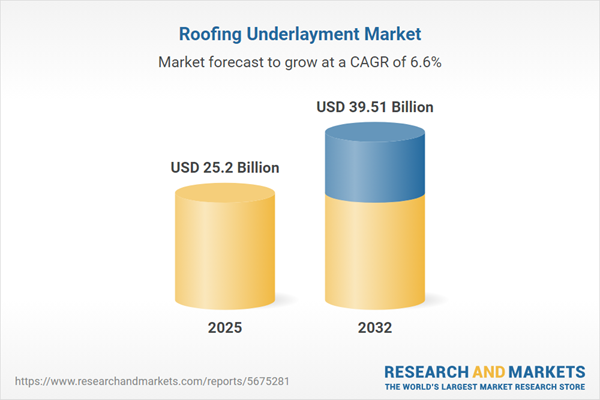Speak directly to the analyst to clarify any post sales queries you may have.
Senior executives in the roofing underlayment industry are navigating a landscape shaped by regulatory complexity, technological advancements, and evolving construction requirements. The global roofing underlayment market continues to demonstrate robust momentum, requiring decision-makers to implement strategies that build resilience and sustain compliance in dynamic environments.
Market Snapshot: Roofing Underlayment Market Outlook
The global roofing underlayment market is valued at USD 23.71 billion, with projections signaling steady growth to USD 25.20 billion by 2025 and USD 39.51 billion by 2032. The market’s compound annual growth rate stands at 6.58%, reflecting expanding investment across commercial development and public infrastructure. Shifting construction practices are emphasizing high-performance underlayment solutions that address stricter regulatory expectations and a need for sustainability across building segments and geographies. Organizations now balance quality, compliance, and project efficiency, making the choice of roofing underlayment increasingly pivotal within project portfolios globally.
Scope & Segmentation of the Roofing Underlayment Market
- Material Categories: Products include asphalt saturated felt, fibre cement, non-bitumen synthetics, and rubberized asphalt, each providing unique resilience against weather extremes and supporting diverse regional standards.
- Type: Fire-resistant, water-resistant, and waterproof variants accommodate distinct safety and compliance needs for both new builds and renovations.
- Form Factors: Sheets and panels designed to complement both contemporary and heritage architecture, streamlining installation and supporting a range of project complexities.
- Installation Methods: Systems offer adhesive, mechanically fastened, and nail-on options to address varying site conditions and align with available technical skill sets.
- Applications: Underlayments are specified for new construction and major refurbishments, enhancing asset protection and long-term risk mitigation for building owners and operators.
- Distribution Channels: Both digital procurement platforms and established supply chains strengthen project assurance and continuity, particularly in time-sensitive scenarios.
- End Use Sectors: Target markets include commercial, industrial, and residential developments, each requiring tailored solutions that conform to operational priorities and lifecycle demands.
- Regional Coverage: The Americas, Europe, Middle East, Africa, and Asia-Pacific experience individual regulatory conditions and construction environments, with significant activity in the United States, Canada, Germany, China, and India.
- Key Companies Monitored: Leading market participants include DuPont de Numerous, Owens Corning, Alpha Pro Tech, Atlas Roofing, Benjamin Obdyke, Carlisle Companies, CertainTeed by Saint-Gobain, Duro-Last, Epilay, GAF Materials, Gardner-Gibson by ICP Group, GCP Applied Technologies, IKO Industries, Intertape Polymer Group, Keene Building Products, MFM Building Products, POLYGLASS by Mapei, PrimeSource Building Products, TAMKO, and United Asphalt by FM Conway.
Key Takeaways: Strategic Insights for Roofing Underlayment Market Leaders
- Synthetic and rubberized underlayments are increasingly favored by industry leaders for their ability to address demanding site conditions and climate variability.
- Procurement teams are prioritizing solutions that align with fire safety and sustainability standards, directly supporting organizational risk management and compliance visibility.
- The introduction of new-generation products aligns with updated construction codes, empowering flexibility in modern design specifications and supporting emerging architectural practices.
- Widespread adoption of digital solutions—such as supply chain analytics and in-situ quality monitoring—provides greater process transparency and enhanced control throughout sourcing and installation phases.
- Sustained collaboration between contractors, suppliers, and technical experts reduces the risk of project interruptions and promotes success in diverse regulatory environments.
- Regional procurement models are evolving to better address local preferences and differences in climate, construction demand, and compliance requirements.
Tariff Impact: Responding to Trade Disruption
Recent changes in U.S. tariffs on roofing underlayment imports have intensified supply chain complexity and elevated procurement costs. Senior leadership teams are proactively reassessing their supply networks, strengthening real-time risk monitoring, and deploying adaptive sourcing strategies to reinforce project reliability against shifting trade conditions.
Methodology & Data Sources
This report is built on a rigorous assessment of secondary market information, industry-specific databases, and executive interviews. Insights from sector experts provide validation for findings and ensure a comprehensive view of current roofing underlayment market trends.
Why This Roofing Underlayment Report Matters
- Enables organizations to realign procurement strategies and develop resilient, adaptive supply chains suitable for changing regulatory landscapes.
- Presents detailed segmentation and actionable, technology-driven recommendations to inform targeted investments and operational decisions.
- Facilitates the integration of proven compliance best practices, minimizing risk of project delays and supporting consistent quality from planning to completion.
Conclusion
This analysis assists executive leaders in anticipating industry shifts, reinforcing compliance frameworks, and transforming procurement practices to support sustainable, long-term performance in the roofing underlayment sector.
Additional Product Information:
- Purchase of this report includes 1 year online access with quarterly updates.
- This report can be updated on request. Please contact our Customer Experience team using the Ask a Question widget on our website.
Table of Contents
3. Executive Summary
4. Market Overview
7. Cumulative Impact of Artificial Intelligence 2025
Companies Mentioned
The companies profiled in this Roofing Underlayment market report include:- DuPont de Numerous, Inc.
- Owens Corning
- Alpha Pro Tech, Ltd.
- Atlas Roofing Corporation
- Benjamin Obdyke Incorporated
- Carlisle Companies Incorporated
- CertainTeed by Saint-Gobain Group
- Duro-Last, Inc.
- Epilay Inc.
- GAF Materials LLC
- Gardner-Gibson Company by ICP Group
- GCP Applied Technologies Inc.
- IKO Industries Ltd.
- Intertape Polymer Group Inc.
- Keene Building Products, Inc.
- MFM Building Products Corp.
- POLYGLASS S.p.A by Mapei S.p.A.
- PrimeSource Building Products, Inc.
- TAMKO Building Products LLC
- United Asphalt Company by FM Conway Ltd
Table Information
| Report Attribute | Details |
|---|---|
| No. of Pages | 195 |
| Published | November 2025 |
| Forecast Period | 2025 - 2032 |
| Estimated Market Value ( USD | $ 25.2 Billion |
| Forecasted Market Value ( USD | $ 39.51 Billion |
| Compound Annual Growth Rate | 6.5% |
| Regions Covered | Global |
| No. of Companies Mentioned | 21 |









